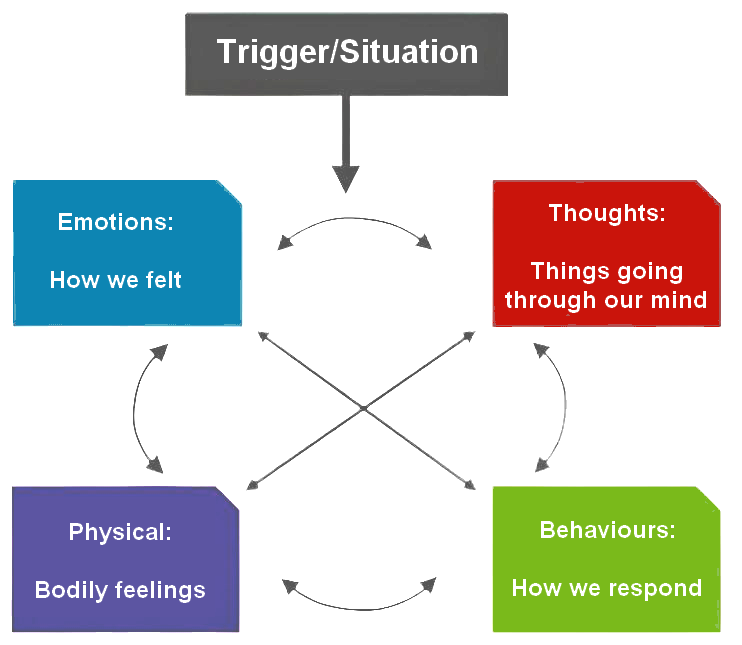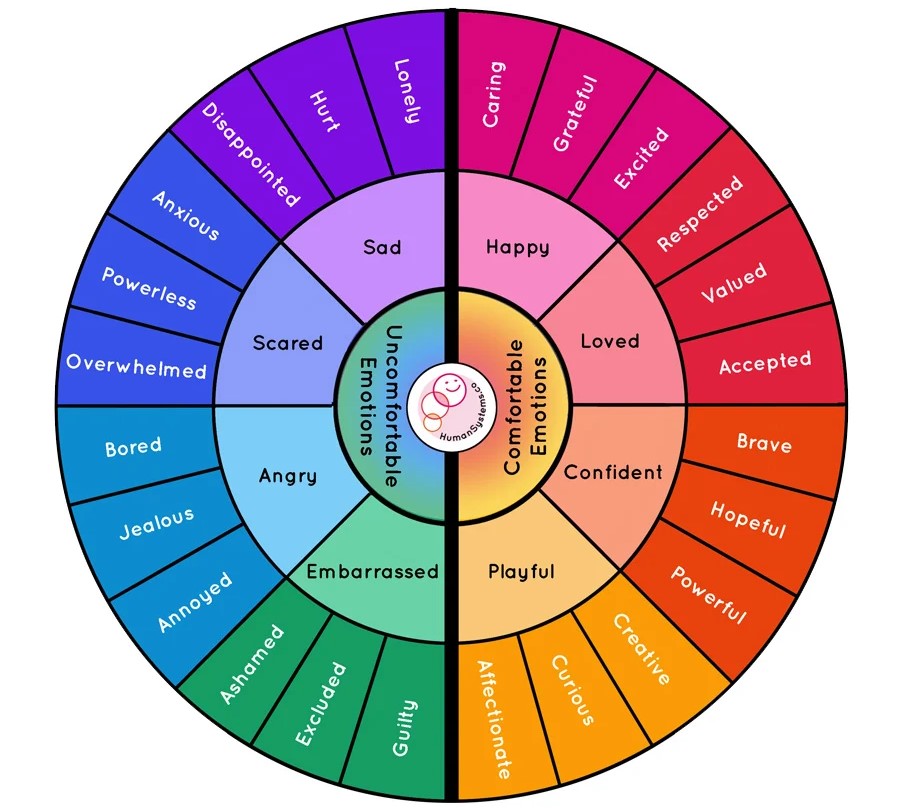We have talked about how working towards a healthier way of living involves:
- setting achievable goals
- increasing our activity levels
- eating the right foods
Knowing how our thoughts and emotions affect our health related behaviours can also be helpful. We may not be aware of our thoughts and feelings a lot of the time.
How we experience life is shaped by how we make sense of things. That is, how we think about them. These thoughts can then affect:
- how we feel
- how our body responds
- what we do
This is shown in the diagram below.

Imagine you have been eating healthily all week. One lunchtime you only get a short break. You end up eating a bar of chocolate instead of your normal lunch.
Unpleasant thoughts like “I’m a failure”, or “I’ve blown it now, there’s no point even trying to eat healthy” might go through your mind.
This could lead you to feel:
- down
- hopeless
- frustrated
You might experience:
- a lack of energy
- hunger pangs
- a stress headache
You might then decide to not eat anything else for the rest of the day, but end up grazing on unhealthy snacks.
Learning more about situations that bring up unpleasant thoughts and emotions can be good for managing our health and mental well-being.
So why not give it a go!
Don’t worry if you struggle at first to notice the link between your thoughts, emotions and what you do. It’s a skill and needs practice.
Everybody overeats sometimes. This is normal. However, when we do this often it can affect our well-being.
Emotional eating
You might overeat because you are bored or tired, happy or excited, or you have had a stressful day. This is known as emotional eating. This is when we eat food, not because we are hungry, but to push away or heighten a certain feeling. Understanding what happens when we engage in emotional eating can help us change this.

The emotion wheel
This emotion wheel shows how many different emotions we can feel, sometimes more than one at a time. Take a moment to have a look round the wheel to see if you recognise any emotions that are familiar to you.

Comfortable emotions:
- Happy: Caring, Grateful, Excited
- Loved: Respected, Valued, Accepted
- Confident: Brave, Hopeful, Powerful
- Playful: Creative, Curious, Affectionate
Uncomfortable emotions:
- Sad: Lonely, Hurt, Disappointed
- Scared: Anxious, Powerless, Overwhelmed
- Angry: Bored, Jealous, Annoyed
- Embarrassed: Ashamed, Excluded, Guilty
It can be tricky to identify the thoughts and emotions that influence our health-related behaviours.
Consistent effort can lead to results. The more you try it, the easier it will get.
Reflecting on emotional eating
Questions to ask yourself when trying to understand what you might have been thinking:
- Was I telling myself that I should/shouldn’t be doing something?
- Was I being self-critical?
- Was I telling myself that I couldn’t do something?
- Was I thinking about something that had just happened?
- Was I thinking about something that might happen?
- Was it a thought I have had before?
- Was I thinking that someone had judged me negatively?
Are there any other questions you could ask yourself?
Being mindful
Practicing being mindful can also help us become more aware of our thoughts and emotions.
Mindfulness can be defined as:
- paying full attention to whatever is happening in the present moment, while passing no judgement
- being completely aware, and curious, of what is going on around you right now
The thing that is happening in the definition above could be something in your external environment that you notice, such as the sound of traffic. Or, it could be something from within you, such as your:
- thoughts
- emotions
- physical symptoms in your body, like a sore neck
What to expect from mindfulness
Every time we practice mindfulness, we are training our brains to focus on the present. We are learning to become more aware of our thoughts and emotions. The aim is not to change how we feel or to relax, although we might have this experience.
We should expect our minds to wander. Each time we bring our focus back to the present moment we are practicing mindfulness. The more we do this, the more mindful we will become.
Formal mindfulness examples:
- Sit quietly and focus on your breathing for a few minutes
- Follow a guided meditation from a wellbeing app
Informal mindfulness examples:
- Pause for a few moments at set times in your day and note any emotions that are present (such as feeling content or sad)
- Observe what you see, hear, smell and feel when out for a walk
Why do things mindfully?
- To bring our focus to the present moment and what is going on inside our bodies and around us
- To increase our awareness of the full range of thoughts and emotions we can have
- To help us then use healthy strategies to deal with unpleasant thoughts and feelings. This is better for you than mindlessly doing something to not feel them, such as eating
Mindfulness resources
Also consider:
Binge eating
Binge eating
While emotional eating is a normal and common eating pattern, some people can experience Binge Eating Disorder (BED).
Key signs of BED include:
- The feeling of being ‘out of control’ when eating
- Eating large amounts without thinking
- Eating very quickly
- Eating until uncomfortably full
- Feelings of guilt/shame
- Hiding/hoarding food
There is no single cause for BED. However, people with BED tend to:
- frequently experience unpleasant emotions
- have low self-esteem
- have a long-standing pattern of irregular eating
Please let us know if you think you have BED.
Talk to us if you feel your emotional eating is out of control. Some people may need extra support to help them gain control of their eating patterns.
Snacking
Sometimes we snack because we are hungry. However, a lot of the time we snack for other reasons. At these times we might be:
- eating out of habit
- eating in response to seeing something that triggers us to want a certain food
- eating out of false hunger. Thirst produces similar symptoms to hunger making us eat rather than drink
- craving food
Noticing when this is happening is the first step to managing snacking. Doing a food diary and rating how hungry we are before we eat can help us identify snacking that is not due to hunger.
If we know that certain situations can bring about certain thoughts and emotions, they bring about less healthy eating habits, we can do something about them. What strategies are best to use at these times will be different for each person.
If you get the urge to snack despite having just had dinner, you may find that running a warm bath is what you need while the craving passes.
if you come home after a busy day at work and feel like eating crisps or biscuits rather than preparing a healthy dinner, you might find that spending five minutes doing some mindful breathing helps you.
Notice if you are having self-critical thoughts. Showing yourself some kindness and understanding may help curb food cravings.
Below, you will find some examples of strategies. We suggest you experiment with these and find those that are most helpful for you.
Thinking differently
When you feel upset or start to crave food, try and identify any thoughts you had before feeling this way. Label any thoughts that are negative, critical or unhelpful.
Ask yourself ‘am I setting myself double standards?’ Often we say harsher things to ourselves than we would to anyone else. Think about how you might respond if someone you cared about was having similar thoughts. Maybe these responses apply to you too.
Ask yourself ‘is there any solid evidence behind the statements I am saying to myself?’ For example, if you are constantly telling yourself that you are a failure, think about whether there are successes in other areas of your life. What does this say about your initial thought?
Even if a thought seems accurate, ask yourself ‘is it helpful for me to think this way, or talk to myself this way?’ ‘Is this thought helping me do the things that are important to me?’
Doing differently
Develop a list of activities or tasks that you might be able to do whilst waiting for the craving to pass.
What would your list look like? Does it include a range of activities – some familiar, some new?
Think about the things you enjoy doing, such as:
- going out for some fresh air
- phoning a friend
- listening to music
Whatever activities you find useful, you will benefit more by trying to do them mindfully.
Challenges
As with any journey, there will be bumps along the way. Using new strategies to deal with emotional eating and cravings will be a learning process. It is likely you will have some slip-ups. This is normal.
It can be useful to predict the possible barriers that might arise when trying to think or do differently. You can then plan for how you might tackle these.
Some potential challenges could include:
- No time to notice what we are thinking or feeling – Schedule mindful moments when you pause, breathe, observe and take note.
- Difficulty understanding our complex emotions and thoughts – Write them out in a notebook and use the emotion wheel to help you.
Key points
- Try to notice when you feel like eating
- Take a moment. Ask yourself, ‘is this because I’m actually hungry?’ or ‘is this because of something else I’m feeling?’
- If it is because of an emotion, ask yourself ‘what was I thinking before I wanted to eat?’ or ‘what emotion am I feeling and where do I feel it in my body?’
- Remember thoughts, emotions and bodily sensations are all connected
- When you’ve recognised the emotion/thought, you can:
- Question your thoughts
- Do a helpful activity/strategy from your list instead of eating as a coping response